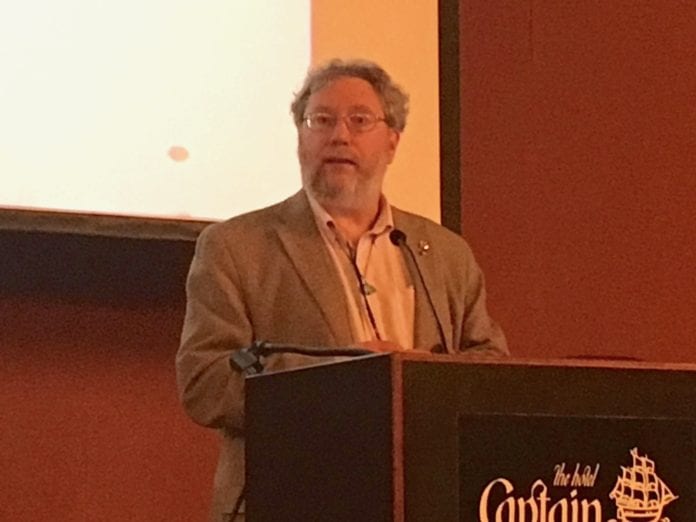Climate science expert Richard Thoman says marine scientists have a great task at hand, to communicate throughout rural Alaska and beyond the need to adapt to Alaska’s changing oceans and to prepare for more to come.
In a keynote speech on Jan. 28 to the 2019 Alaska Marine Science Symposium in Anchorage Thoman said elders with traditional knowledge in rural Alaska are validating the research observations of marine scientists and others about the impacts of warming oceans, the decline of sea ice, coastal flooding and erosion, changes to fisheries, increasing algal blooms and shellfish poisoning, and more, and the impact of all this on traditional subsistence activities.
Warming ocean waters and decreasing sea ice has already generated cascading impacts to thre biology and the larger climate and environmental system for which most people have only a limited understanding, said Thoman.
He urged symposium participants at the Hotel Captain Cook to communicate with fellow Alaskans, particularly in rural areas, about how climate is changing and the need to adapt now. Thoman has worked on Alaska weather and climate issues for more than 30 years. After retiring from the National Weather Service Alaska Region as the climate science and services manager, he joined the Alaska Center for Climate Assessment and Policy as a climate specialist.
The focus of ACCAP’s work is improving the ability of Alaskans to respond to the rapid changes in climate to date and more to come. ACCAP also studies marine resources and assess climate change related impacts on water availability, sea ice, wildfires and Alaska Native culture.
For information about joining an ACCAP webinar on changing climate log on to https://accap.uaf.edu/webinars/join-accap-webinar.
“We’re on the radio every week building relationships,” said Thoman, as he urged AMSS participants to share what they know on social media. “Facebook is widely used in rural Alaska,” he said. “It is the way to communication with rural Alaska.” In the case of Little Diomede, where Internet connections may be less reliable ACCAP communicates by telephone one-on-one, he said. “Do more,” he told the gathering of scientists and others. Share your work out there with Alaskans.”
Thoman was one of dozens of speakers at the 2019 symposium, which began on Jan. 28 and was to conclude on Feb.1.
The focus of keynote presentations this year included adapting to climate change, earthquakes and tsunamis, and their scientific legacy of the Exxon Valdez oil spill.
First day events also included the presentation of the 2019 Alaska SeaLife Center-Alaska Ocean Leadership Marine Research Award to Kathy Frost and the late Lloyd Lowry, biologists for the Alaska Department of Fish and Game, based in Fairbanks, who were key on the ground restoration scientists in Prince William Sound following the Exxon Valdez oil spill. In a tribute to them posted in the symposium program, AMSS said their passion for studying marine mammals and informing others about that research has inspired may scientists, subsistence hunters and managers. “The manuscripts and data they both produced will be cited for decades to come and their work ethic has inspired scientists and non-scientists alike,” the tribute said.
The symposium always focuses on the second day on Gulf of Alaska issues, on the third day on the Bering Sea and Aleutian Islands and on the fourth day of the Arctic, on a range of topics from climate and oceanography to fish, seabirds, marine mammals and human dimensions of each area.
This year’s Gulf of Alaska presentations included the impact of the marine heat wave on Gulf of Alaska plankton communities, the effects of ocean acidification on Alaska bivalves of subsistence importance, reproductive access between hatchery strays and wild pink salmon in a natural stream in Prince William Sound, tropic connections between sperm whales and their prey in the Gulf of Alaska and brown bears and sea otters along the Katmai coast.
Commercial exploitation in the 18th and 19th centuries eliminated sea otters from most of their range, including the coastal area of what is now Katmai National Park and Preserve, noted presenter Daniel Monson of the NOAA’s Alaska Science Center. But a remnant sea otter population remained north of Cape Douglas and by the early 1990s the sea otter population had expanded. Sea otter abundance has increased seven-fold since the early 1990s and now appears to be approaching carrying capacity, he said.
Sea otters along that coast utilize offshore islands as haul out sites where brown bears are also often found. Since 2006, scientists have collected sea otter carcasses from the offshore islands along that coast, with most carcasses showing signs of being consumed by brown bears, he said. While population models using the carcass collections as representatives sea otter age-at-death suggest the population should be declining, but that contrasts with sea otter surveys that do not suggest a decline over a similar time frame, he said.















